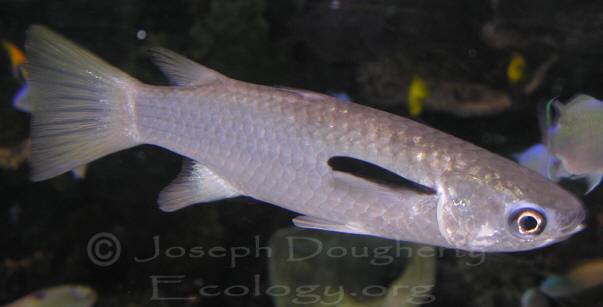Taxonomic Classifications of Liza vaigiensis
Domain: Eukarya
Kingdom: Animalia
Phylum: Chordata
Class: Actinopterygii
Order: Mugiliformes
Family: Mugilidae
Genus: Liza
Species: Liza vaigiensis
Domain- Eukarya
Cells of Eukarya contain a membrane bound nucleus in which genetic material is carried.
Kingdom – Animalia
All members of the kingdom of Animalia are both multicellular and heterotrophic which distinguishes them from other kingdoms. Most members of the kingdom digest consumed organisms within an internal cavity.
Phylum – Chordata
Chordates are bilaterally symmetrical which leads to cephalization and rod-like nerve cords, not to be associated with a backbone or vertebral column. More commonly known chordates are vertebrates which include fish, amphibians, reptiles, birds, and mammals.
Class – Actinopterygii
The Actinopterygii Class includes nearly all of the thirty thousand species of fish due to the ray fins found on the fish. The ray fins act as cites for the origin and insertion of muscle groups. When combined with the caudal fin (tail fin), the ray fins of the actinopterygii class and corresponding muscles allow for greater control and power of movement for theses species of fishes. Sizes and shapes of ray fins vary between species, as well as quantity of rays. The Liza vaigiensis has eight.
Order – Mugiliformes
This order contains only the family of Mugilidae commonly known as mullet.
Family – Mugilidae
Contains the only family of the Mugiliforme order. All mullet possess svelte bodies, two separated dorsal fins, pectoral fins, and a forked tail.
Genus – Liza
The fishes of this genus contain similarities to the stripped mullet native to Caribbean coastal waters and named accordingly.
Species – Liza vaigiensis
The Liza vaigiensis name depicts a silvery-grey, diamond-scale mullet, while possessing black fins.
Figure 1.1. Phylogenic tree depicting relationships between several clades of animals
differentiating themselves from Bacteria, Archaea, and Fungi.
Begin on the left and notice the separation from the most distant relatives, the Bacteria and Archaea, of which both are Prokaryotes. Encompassing a diverse array of organisms, the Opisthokonta phylum is represented demonstrating that both fungi and animals are members of this phyla due to the flattened cristae membrane inside the mitochondria in each cell used for glycolysis. Porifera, an exclusively aquatic phyla are not bilateral, a characteristic leading to cephalization, thus share less ancestry with the Liza vaigiensis. Continuing along the ancestry, the organism phyla increase in complexity where lophotrocozoans, chordates, and echinoderms, are all bilaterally symmetrical. Finally, being the most complex and ancestrally similar, the echinoderms and chordates form a clade of deuterostomes, where the anus developed first. This contrasts protostomes, where the mouth develops first, which Lophotrocozoa can be categorized.
Figure 1.2 New Classifications of Bony Fishes including Mugilidae to which Liza vaigiensis belongs.
The Ovalentariae clade encompasses the Actinopterygii classification of fishes due to the ray-fin phenotypes of which Liza vaigiensis resides. This phylogeny provides illustration of the evolution of all major classifications of Ovalentariae along with illustrations exhibiting body shape and fins present on the differentiated families of fishes. In this particular investigation of several families of fishes, bootstrap support; bettering oneself without assistance was quantified, and provided the researchers with data supporting the phylogeny and estimated time frame for species evolution. After data was compiled, researchers reclassified several species of boney fishes, including the Liza vaigiensis. Visit
PLOS New Classifications of Bony Fishes for more information on the study.

